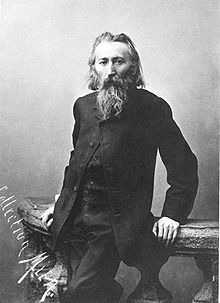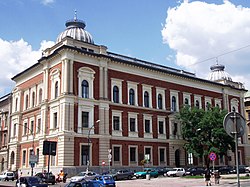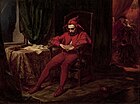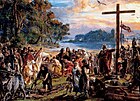Jan Matejko
Jan Matejko | |
|---|---|
 Jan Matejko, Self-portrait, 1892 | |
| Born | Jan Mateyko June 24, 1838 |
| Died | November 1, 1893 (aged 55) |
| Nationality | Polish |
| Education | School of Fine Arts, Kraków |
| Known for | Painting, drawing |
| Notable work | Battle of Grunwald Stańczyk The Prussian Homage |
| Movement | History painting |
Jan Alojzy Matejko () (also known as Jan Mateyko; June 24, 1838[nb 1] – November 1, 1893) was a Polish painter known for paintings of notable historical Polish political and military events.[2][3] His works include large oil on canvas paintings like Rejtan (1866), Union of Lublin (1869) or Battle of Grunwald (1878), numerous portraits, a gallery of Polish kings, and murals in St. Mary's Basilica, Kraków. He is counted among the most famous Polish painters.[2][3][4]
Matejko spent most of his life in Kraków. His teachers at the Kraków Academy of Fine Arts included Wojciech Korneli Stattler and Władysław Łuszczkiewicz. Later, he became a director at this institution, which eventually was renamed the Jan Matejko Academy of Fine Arts. A number of his students became prominent painters themselves, including Maurycy Gottlieb, Jacek Malczewski, Józef Mehoffer and Stanisław Wyspiański.
Biography
Youth
Matejko was born on June 24, 1838, in the Free City of Kraków.[2] His father, Franciszek Ksawery Matejko (Template:Lang-cs) (born 1789 or January 13, 1793, died October 26, 1860), a Czech from the village of Roudnice, was a graduate of the Hradec Králové school who later became a tutor and music teacher.[2] He first worked for the Wodzicki family in Kościelniki, Poland, then moved to Kraków, where he married the half-German, half-Polish Joanna Karolina Rossberg (Rozberg).[2] Jan was the ninth child of eleven that his parents had.[5] He grew up in a kamienica building on Floriańska Street.[6] After the death of his mother in 1845, Jan and his siblings were cared for by his maternal aunt, Anna Zamojska.[5]

At a young age he witnessed the Kraków revolution of 1846 and the 1848 siege of Kraków by the Austrians, the two events which ended the existence of the Free City of Kraków.[2] His two older brothers served in them under General Józef Bem; one died and the other was forced into exile.[2] He attended St. Ann's High School, which he dropped out of in 1851 because of poor results.[7] From his earliest days Matejko showed artistic talent, but he had great difficulty with other subjects.[7] He never mastered a foreign language.[8] Despite that and because of his exceptional talent he studied at the School of Fine Arts in Kraków from 1852 to 1858.[2] His teachers included Wojciech Korneli Stattler and Władysław Łuszczkiewicz.[9] He selected historical painting as his specialization, and finished his first major work, Tsars Shuyski before Zygmunt III (Carowie Szujscy przed Zygmuntem III), in 1853 (he would return to this topic in a year before his death, in 1892[10]).[9][11] During this time, he began exhibiting historical paintings at the Kraków Society of Friends of Fine Arts (starting with 1855).[11] His seminal project for his graduation in 1858 was Sigismund I the Old ennobles the professors of the Jagiellonian University (Zygmunt I nadaje szlachectwo profesorom Uniwersytetu Jagiellońskiego).[12]
Following his graduation,[12] Matejko received a scholarship to study under Hermann Anschütz at the Academy of Fine Arts, Munich in 1859.[11] Next year he also received a scholarship to study at Academy of Fine Arts Vienna, but after a few days and a major quarrel with Christian Ruben, Matejko returned to Kraków.[13] There he opened a studio at his family house at Floriańska Street.[13] It would however be years before he would gain commercial success; for a time he was the proverbial "starving artist", who celebrated when he sold a canvas (the Tsars Shuyski...) for five gulden.[2]
In 1860 Matejko issued an illustrated album, Clothing in Poland (Ubiory w Polsce), a project reflecting his intense interest in historical records of all kinds and his desire to promote such interest among the Polish people in an effort to intensify their patriotic feelings.[13] His financial situation improved with the sale of two paintings, Death of Wapowski during the crowining of Henry Valois (Zabicie Wapowskiego w czasie koronacji Henryka Walezego, 1861) and Jan Kochanowski mourning his daughter Urszulka (Jan Kochanowski nad zwłokami Urszulki, 1862), which settled his debts.[14] In 1862 he finished a painting, Stańczyk.; initially received without much applaud, in time it would become known as one of Matejko's most famous masterpieces.[15] In Matejko's art style, it visibly marks a transition from simply illustrating history to being the artist's philosophical and moral commentary of it.[13]

During the January Uprising of 1863, in which he did not participate because of poor health, Matejko gave financial support, donating most of his savings to the cause, and personally transported arms to the insurgents' camp.[13] His Skarga's Sermon (Kazanie Skargi), finished in May 1864, was displayed in the gallery of the Kraków Society of Friends of Fine Arts, which gained him much publicity.[13] On 5 November that year, in recognition for his contributions to recreating historical themes, he became a member of the Kraków Scientific Society (Towarzystwo Naukowe Krakowskie).[16] Soon afterward, on 21 November, he married Teodora Giebultowska, with whom he would have five children: Beata, Helena, Tadeusz, Jerzy and Regina.[13] Helena, his daughter, also an artist, helped victims in World War I and was awarded the Cross of Independence by president Stanisław Wojciechowski.[17]
Rise to fame


At that time Matejko started to gain international recognition. In 1865 Matejko's painting Skarga's Sermon was awarded a gold medal at the yearly Paris salon; soon afterwards Count Maurycy Potocki bought it for 10,000 guldens.[2] In 1867, his painting Rejtan was awarded a gold medal at the World Exhibition in Paris and acquired by Emperor Franz Joseph I of Austria for 50,000 franks.[18][19] His next major painting was the Union of Lublin (Unia Lubelska), created in the years 1867-1869. Once again applauded in Paris, it yielded Matejko a Cross of the French Légion d'honneur.[20] It was purchased by the Sejm of Galicia.[21] Union... was followed by Stefan Batory at Pskov (Stefan Batory pod Pskowem), finished in 1871.[20] In 1872 he visited Istanbul in the Ottoman Empire, and upon his return to Kraków he finished Astronomer Copernicus, or Conversations with God (Astronom Kopernik, czyli rozmowa z Bogiem), which was acquired by the Jagiellonian University.[20] From the 1870s he was aided in many tasks by a secretary, Marian Gorzkowski, who would become his "right hand", his closest friend, a model for a number of paintings, and an author of memoirs about Matejko.[21][22]
In 1872 during an exhibition in Prague he was offered a directorship of Academy of Fine Arts, Prague, and soon afterwards, a similar position at the Kraków's School of Fine Arts.[20] He accepted the Kraków's offer, and was for many years the principal (rector) of the Academy of Fine Arts.[20] In 1874 he finished Zawieszenie dzwonu Zygmunta (The Hanging of the Sigismund bell).[23] In 1878 he finished another masterpiece, Battle of Grunwald.[21] That year he received an "honorary grand gold" medal in Paris, and the city council of Kraków presented him with a ceremonial scepter, a symbol of his "royal status in fine arts".[21] In year 1879 he finished working on Rok 1863 - Polonia (Year 1863 - Polonia), his take on the contemporary January Uprising. Begun in 1864, a year after the Uprising he himself lived through and where he lost a number of friends and family members, Matejko abandoned work on this canvas until prince Władysław Czartoryski became interested in acquiring it; it is still considered unfinished.[13][24][25]
Years 1880-1882 marked his work on another large painting, Prussian Tribute (Hołd Pruski).[21] Matejko gifted this painting to "the Polish nation", and it earned him honorary citizenship of Kraków; one of the squares in the city was also named Matejko Square.[21] In 1883 he finished Sobieski at Vienna (Sobieski pod Wiedniem).[11][21] Sobieski... was gifted to Pope Leo XIII as a "gift of the Polish nation" and Matejko who was one of the members of the group delivering it received a Knight Commander with Star Order of Pius IX.[26] At that time he also became a vocal spokesman in a number of political issues, publishing letters on issues such as Polish-Russian relations.[26] Another arena he was very engaged in were efforts to protect and reconstruct various historical monuments in the city of Kraków.[27] In 1886 he finished a painting focusing not on Polish, but on French history: Virgin of Orléans, portraying Joan of Arc.[26][28] Next year Matejko received the degree of Doctor of Philosophy, honoris causa, from the Jagiellonian University, and the Austrian Litteris et Artibus.[26] In 1888 he finished Batte of Racławice (Bitwa pod Racławicami).[26] In 1888-1899, to justify his new academic title, he published a cycle of twelve sketches with an accompanying commentary, History of civilization in Poland (Dzieje Cywilizacji w Polsce).[23][26] From 1890 to 1892 he published another cycle of sketches, this time of Polish kings (Poczet królów i książąt polskich - Fellowship of the kings and princes of Poland), which over the years became so popular they are seen as their canon portrayals.[26][29] 1891 saw him finishing Constitution of the 3 May (Konstytucja 3 Maja).[26] He then began composing another large painting, Oaths of Jan Kazimierz (Śluby Jana Kazimierza), but it remained unfinished due to his death.[26] In 1892, a year before his death, he finished a Self-portrait (Autoportret).[26]
Suffering from a peptic ulcer, on 30 October 1893 he suffered from internal bleeding, and died in Kraków on November 1 that year.[27] His funeral on November 5 drew large crowds, and his death was mentioned in at least thirty two European newspapers.[30] He was buried in the Kraków's Rakowicki Cemetery.[27]
Significance, style and themes

He is counted among the most famous Polish painters,[2][3] described as "Poland's greatest historical painter"[4] and "a cult figure to the nation at large... [already] by the time of his death.".[23] His style was praised for being "colourful, detailed and imaginative".[23] He succeeded in propagating Polish history, and reminding the world about Poland, while his country remained partitioned and without any independent political representation.[2] His works, disseminated in thousands of reproductions, have become almost standard illustrations of many key events in Polish history.[2][3] His 1860 illustrated album Ubiory w Polsce (Clothing in Poland) is seen as a valuable historical reference.[31] Critics of his work have pointed to his use of traditional painting style ("antiquarian realism", "theatrical effects").[32] At exhibitions abroad the nuanced historical context of his works would be often lost on foreign audiences.[11][23] Occasionally his paintings would cause controversy; for example Rejtan offended a number of prominent members of Polish nobility, who saw the painting as an indictment of their entire social class.[20][23] His paintings were subject to censorship in the Russian Empire, and Nazi Germany planned to destroy Battle of Grunwald and the Prussian Homage, which the Nazi authorities considered offensive to the German view of history (those paintings were among many that the Germans planned to purposefully destroy in their war on Polish culture; both were however successfully hidden by the members of Poland resistance).[33]
Many of his works are dedicated to famous events in Polish history. Matejko was focusing on major themes in Polish history and using historical sources to paint events in minute historical detail.[34] His earliest paintings are simple historical paintings with no hidden messages.[13] The later ones, starting with the painting Stańczyk (1862), are intended to inspire the viewers with a patriotic message.[13][35] Stańczyk focuses on the court jester, portrayed as a symbol of country's conscience, sitting in a chair in the background of a party - a sole figure reflecting on the war, ignored by the joyful crowd.[23]
In addition to history paintings Matejko made also numerous portraits.[26] Among others: portraits of Jagiellonian University rectors Józef Szujski and Stanisław Tarnowski, and numerous portraits of family and friends, including Wife in the wedding dress ("Żona w sukni ślubnej") (1865, destroyed by his wife during a quarrel and recreated in 1879) and a self-portrait (1892).[26] Altogether Matejko authored 320 oil paintings and several thousands drawings and watercolors.[citation needed] He also designed the polychrome in St. Mary's Basilica, Kraków (1889–1891).[36]
His paintings are on display in numerous Polish museums; including the National Museum in Warsaw, National Museum in Kraków, National Museum in Poznań and National Museum in Wrocław.[27] National Museum in Kraków has a branch dedicated to Matejko - House of Jan Matejko (Dom Jana Matejki) located in his former studio and family house at Floriańska Street, opened in 1898.[27][37] Another museum dedicated to Matejko, Dworek Jana Matejki, opened in Krzesławice (where Matejo acquired a manor[21]) in 1865.[38]
Over 80 painters have been Matejko's students at some point, many influenced during his tenure as the director of the Kraków School of Fine Arts, and are referred to as members of "Matejko School".[23][39] Prominent among them are Maurycy Gottlieb,[39] Ephraim Moses Lilien,[40] Jacek Malczewski,[39] Józef Mehoffer,[39] Antoni Piotrowski,[39] Witold Pruszkowski,[39] Leon Wyczółkowski,[39] and Stanisław Wyspiański.[39]
Selected works
Following is the list of Matejko's selected works, in a chronological order.
| # | Title | Year | Technique and size | Location | Illustration |
| 1. | Carowie Szujscy przed Zygmuntem III (Tsars Shuyski before King Sigismund III) | 1853 | oil on canvas 75.5 cm × 109 cm |
National Museum in Wrocław | 
|
| 2. | Stańczyk | 1862 | oil on canvas 120 × 88 cm |
National Museum, Warsaw | 
|
| 3. | Kazanie Skargi (Skarga's Sermon) | 1864 | oil on canvas 224 × 397 cm |
Royal Castle, Warsaw | 
|
| 4. | Rejtan | 1866 | oil on canvas 282 × 487 cm |
Royal Castle, Warsaw | 
|
| 5. | Alchemik Sędziwój (Alchemist Sendivogius) | 1867 | oil on canvas 73 × 130 cm |
Museum of Arts in Łódź | 
|
| 6. | Unia Lubelska (Union of Lublin) | 1869 | oil on canvas 298 cm × 512 cm |
Lublin Museum | 
|
| 7. | Stefan Batory pod Pskowem (Stefan Batory at Pskov) | 1872 | oil on canvas 322 × 545 cm |
Royal Castle, Warsaw | 
|
| 8. | Astronom Kopernik, czyli rozmowa z Bogiem (Astronomer Copernicus, or Conversations with God) | 1873 | oil on canvas 225 × 315 cm |
Collegium Novum | 
|
| 9. | Zawieszenie dzwonu Zygmunta (The Hanging of the Sigismund bell) | 1874 | oil on wood 94 × 189 cm |
National Museum, Warsaw | 
|
| 10. | Śmierć króla Przemysła II (Death of King Przemysł II) | 1875 | Modern Gallery in Zagreb | 
| |
| 11. | Bitwa pod Grunwaldem (Battle of Grunwald) | 1878 | oil on canvas 426 × 987 cm |
National Museum, Warsaw | 
|
| 12. | Polonia - Rok 1863 (Polonia - year 1863) | 1879 | oil on canvas 156 × 232 cm |
Czartoryski Museum, Kraków | 
|
| 13. | Hołd pruski (The Prussian Homage) | 1880-82 | oil on canvas 388 × 875 cm |
National Museum, Kraków | 
|
| 14. | Jan III Sobieski pod Wiedniem (John III Sobieski at Vienna) | 1883 | Vatican Museums | 
| |
| 15. | Wernyhora | 1883-84 | oil on canvas 290 × 204 cm |
National Museum, Kraków | 
|
| 16. | Założenie Akademii Lubrańskiego w Poznaniu (Founding of the Lubrański Academy in Poznań) | 1886 | National Museum, Poznań | 
| |
| 17. | Dziewica Orleańska (Maid of Orléans) | 1886 | oil on canvas 484 x 973 cm |
National Museum, Poznań | 
|
| 18. | Bitwa pod Racławicami (Battle of Racławice) | 1888 | oil on canvas 450 × 890 cm |
National Museum, Kraków | 
|
| 19. | cycle Dzieje cywilizacji w Polsce (History of civilization in Poland) | 1888-1889 | |||
| 20. | Chrzest Litwy (Baptism of Lithuania) | 1888 | oil on canvas 60 × 115.5 cm |
National Museum, Warsaw | 
|
| 21. | Zaprowadzenie chrześcijaństwa (Introduction of Christianity [to Poland]) | 1889 | oil on wood 79 × 120 cm |
National Museum, Warsaw | 
|
| 22. | cycle Poczet królów i książąt polskich (Fellowship of the kings and princes of Poland) | 1890-1892 | |||
| 23. | Konstytucja 3 Maja 1791 r. (Constitution of May 3, 1791) | 1891 | oil on canvas 247 cm × 446 cm |
Royal Castle, Warsaw | 
|
| 24. | Carowie Szujscy przed Zygmuntem III (Tsars Shuyski before King Sigismund III) | 1892 | oil on wood 42 cm × 63 cm |
Jan Matejko House in Kraków | 
|
| 25. | Self-portrait (Autoportret) | 1892 | oil on canvas 160 cm × 110 cm |
National Museum, Warsaw | 
|
| 26. | Śluby Jana Kazimierza (Oath of Jan Kazimierz) | 1893 | oil on wood 315 cm × 500 cm |
National Museum, Wrocław | 
|
See also
Notes
References
- ^ Maria Szypowska (September 2011). Jan Matejko wszystkim znany (in Polish). Fundacja Artibus-Wurlitzer oraz Wydawn. Domu Słowa Polskiego. pp. 7–8.
{{cite book}}: Check date values in:|year=/|date=mismatch (help) - ^ a b c d e f g h i j k l m "Jan Matejko: The Painter and Patriot Fostering Polish Nationalism". Info-poland.buffalo.edu. Retrieved 2011-09-12.
- ^ a b c d "History's Impact on Polish Art". Info-poland.buffalo.edu. Retrieved 2011-09-12.
- ^ a b William Fiddian Reddaway (1971). The Cambridge History of Poland. CUP Archive. p. 547. GGKEY:2G7C1LPZ3RN.
- ^ a b Maria Szypowska (September 2011). Jan Matejko wszystkim znany (in Polish). Fundacja Artibus-Wurlitzer oraz Wydawn. Domu Słowa Polskiego. p. 12.
{{cite book}}: Check date values in:|year=/|date=mismatch (help) - ^ Maria Szypowska (September 2011). Jan Matejko wszystkim znany (in Polish). Fundacja Artibus-Wurlitzer oraz Wydawn. Domu Słowa Polskiego. p. 11.
{{cite book}}: Check date values in:|year=/|date=mismatch (help) - ^ a b Maria Szypowska (September 2011). Jan Matejko wszystkim znany (in Polish). Fundacja Artibus-Wurlitzer oraz Wydawn. Domu Słowa Polskiego. pp. 18, 22–23.
{{cite book}}: Check date values in:|year=/|date=mismatch (help) - ^ Maria Szypowska (September 2011). Jan Matejko wszystkim znany (in Polish). Fundacja Artibus-Wurlitzer oraz Wydawn. Domu Słowa Polskiego. p. 18.
{{cite book}}: Check date values in:|year=/|date=mismatch (help) - ^ a b Maria Szypowska (September 2011). Jan Matejko wszystkim znany (in Polish). Fundacja Artibus-Wurlitzer oraz Wydawn. Domu Słowa Polskiego. p. 25.
{{cite book}}: Check date values in:|year=/|date=mismatch (help) - ^ Jan Matejko; Jerzy Malinowski; Krystyna Sroczyńska; Jurij Birjułow (1993). Matejko: Album (in Polish). Arkady.
Matejko malował nadto dwukrotnie sceny hołdu carów Szujskich przed Zygmuntem III w 1853 i 1892 roku."
[Google Books does not display page number for this book] - ^ a b c d e Bochnak (1975), p. 185
- ^ a b Maria Szypowska (September 2011). Jan Matejko wszystkim znany (in Polish). Fundacja Artibus-Wurlitzer oraz Wydawn. Domu Słowa Polskiego. p. 39.
{{cite book}}: Check date values in:|year=/|date=mismatch (help) - ^ a b c d e f g h i j Bochnak (1975), p. 186
- ^ Maria Szypowska (September 2011). Jan Matejko wszystkim znany (in Polish). Fundacja Artibus-Wurlitzer oraz Wydawn. Domu Słowa Polskiego. p. 78.
{{cite book}}: Check date values in:|year=/|date=mismatch (help) - ^ Maria Szypowska (September 2011). Jan Matejko wszystkim znany (in Polish). Fundacja Artibus-Wurlitzer oraz Wydawn. Domu Słowa Polskiego. p. 85.
{{cite book}}: Check date values in:|year=/|date=mismatch (help) - ^ Henryk Marek Słoczyński (2000). Matejko (in Polish). Wydawn. Dolnośląskie. p. 81. ISBN 978-83-7023-820-9.
- ^ AB (2002-12-05). "Helena z Matejków Unierzyska". Miasta.gazeta.pl. Retrieved 2009-09-19.
- ^ Projekt. Prasa-Książka-Ruch. 1992. p. cxliii.
- ^ Jan Matejko (1993). Matejko: obrazy olejne : katalog. Arkady. p. 1963. ISBN 978-83-213-3652-7.
- ^ a b c d e f Bochnak (1975), p. 187
- ^ a b c d e f g h Bochnak (1975), p. 188
- ^ Stanisław Wyspiański; Maria Rydlowa (1994). Listy Stanisława Wyspiańskiego do Józefa Mehoffera, Henryka Opieńskiego i Tadeusza Stryjeńskiego (in Polish). Wydawnictwo Literackie. p. 75. ISBN 978-83-08-02562-8.
- ^ a b c d e f g h Wanda Małaszewska. "Matejko, Jan." Grove Art Online. Oxford Art Online. Oxford University Press, accessed May 28, 2014, http://www.oxfordartonline.com/subscriber/article/grove/art/T055919
- ^ Stowarzyszenie Historyków Sztuki (1979). Sztuka XIX wieku w Polsce (in Polish). Państwowe Wydawn. Naukowe. pp. 31–32.
- ^ Mieczysław Treter (1939). Matejko: osobowosc artysty, tworczosc, forma i styl (in Polish). Książnica-Atlas. p. 611.
- ^ a b c d e f g h i j k l Bochnak (1975), p. 189
- ^ a b c d e Bochnak (1975), p. 190
- ^ Roxana Radvan; John F. Asmus; Marta Castillejo; Paraskevi Pouli; Austin Nevin (1 December 2010). Lasers in the Conservation of Artworks VIII. CRC Press. p. 173. ISBN 978-0-415-58073-1.
- ^ Barbara Ciciora-Czwórnóg (2005). Jan Matejko (in Polish). Bosz. p. 14. ISBN 978-83-89747-16-7.
- ^ Maria Szypowska (September 2011). Jan Matejko wszystkim znany (in Polish). Fundacja Artibus-Wurlitzer oraz Wydawn. Domu Słowa Polskiego. p. 428.
{{cite book}}: Check date values in:|year=/|date=mismatch (help) - ^ "WYSTAWA: Wielka rekwizytornia artysty. Stroje i kostiumy z kolekcji Jana Matejki". Muzeum Narodowe w Krakowie. 2012. Retrieved 15 March 2014.
{{cite web}}: Unknown parameter|trans_title=ignored (|trans-title=suggested) (help) - ^ Jerzy Jan Lerski (1996). Historical Dictionary of Poland, 966-1945. Greenwood Publishing Group. p. 343. ISBN 978-0-313-26007-0.
- ^ Batorska, Danuta. "The Political Censorship of Jan Matejko". Art Journal. 51 (1): 57. doi:10.2307/777255.
- ^ Ian Chilvers (10 June 2004). The Oxford Dictionary of Art. Oxford University Press. p. 452. ISBN 978-0-19-860476-1.
- ^ Geraldine Norman (1 January 1977). Nineteenth-century Painters and Painting: A Dictionary. University of California Press. p. 181. ISBN 978-0-520-03328-3.
- ^ Stanisława Serafińska (1958). Jan Matejko: wspomnienia rodzinne (in Polish). Wydawn. Literackie. p. 575.
- ^ "O oddziale". Muzeum.krakow.pl. Retrieved 2014-05-29.
- ^ Bochnak (1975), p. 191
- ^ a b c d e f g h ""Artists from the School of Jan Matejko" | Event". Culture.pl. Retrieved 2014-05-29.
- ^ Glenda Abramson (1 March 2004). Encyclopedia of Modern Jewish Culture. Routledge. p. 523. ISBN 978-1-134-42865-6.
Bibliography
- Adam Bochnak; Władysław Konopczyński (1975). Jan Matejko (in Polish). Vol. XX.
{{cite encyclopedia}}:|work=ignored (help)
Further reading
- Batorska, Danuta (Spring 1992). "The Political Censorship of Jan Matejko". Art Journal. 51 (1). Uneasy Pieces: 57–63. doi:10.2307/777255. JSTOR 777255. JSTOR
External links
- A gallery of paintings with links to biography (289 words) and bibliographical pages (12 books).
- Matejko gallery, wawel.net
- Matejko gallery, malarze.com
- Jan Matejko, culture.pl
- "Clothing and Costumes..." From the Collection of Jan Matejko Template:Pl icon
- "Artists from the School of Jan Matejko"
- www.Jan-Matejko.org A website dedicated to Matejko
- Polish painters
- 1838 births
- 1893 deaths
- Artists from Kraków
- Burials at Rakowicki Cemetery
- Légion d'honneur recipients
- Matejko family
- Military art
- Jan Matejko Academy of Fine Arts alumni
- Jagiellonian University alumni
- Polish people of Czech descent
- 19th-century painters of historical subjects
- 19th-century Polish painters
